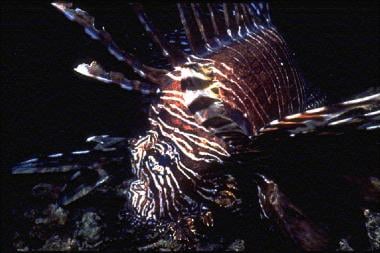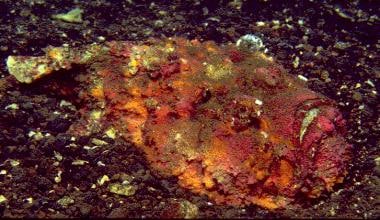Background
The family Scorpaenidae represents a large array of fish characterized by the ability to envenomate with various types of specialized spines. This group of fish is responsible for the second most common piscine envenomation, after stingrays.
Unfortunately, this family of fish has a confusing variety of common names, which tends to hinder accurate field identification, classification, and understanding of envenomation. It is helpful to consider the Scorpaenidae family as three distinct groups, based upon their venom organ structure and toxicity.
These three groups and their representative genera include the following (see the images below) [1] :
Injury and envenomation are reported in the natural environment (eg, accidental exposure to waders, divers, fishermen), as well as in the home setting (eg, handling by unwary marine aquarists). [1]
See Deadly Sea Envenomations, a Critical Images slideshow, to help make an accurate diagnosis.
Pathophysiology
Common to the family Scorpaenidae are 12-13 dorsal spines, two pelvic spines, and three anal spines. Each spine is associated with a pair of venom glands. A loose integumentary sheath covers each spine. The sheath is pushed down the spine during envenomation, causing compression of the venom glands located at the base of the spines. Venom then travels from the glands through anterolateral depressions in the spines and into the wound, in a manner analogous to that of a stingray envenomation. The pectoral spines, while often ornate and plumelike, are innocuous. The venom toxicity is due to antigenic, heat-labile proteins of high molecular weight. Treatment is based on the proposed heat-labile characteristics of these proteins.
Epidemiology
United States
The true number of Scorpaenidae envenomations is unknown. However, there are more than 100 reported cases of captive lionfish (genus Pterois) envenomations in the medical literature, nearly all of which occur on the hands of unwary marine aquarists. Reports from coastal locales commonly involve fisherman, divers, and other water enthusiasts who inadvertently may step on or carelessly handle members of the Scorpaenidae family.
International
This large family is widespread throughout the tropical, subtropical, and temperate regions. Some species are even found in polar regions. No accurate estimates regarding the international frequency of Scorpaenidae envenomations are available; however, they are not uncommon. While the tropical seas contain the majority of species, the temperate waters of the Indo-Pacific, India, South Africa, Australia, Philippines, China, Japan, and the United States are home to many venomous Scorpaenidae.
Prognosis
The severity of Scorpaenidae envenomations is progressively worse from Pterois to Scorpaena to Synanceia species.
Pterois (eg, lionfish, zebrafish, turkey fish, butterfly cod): In one series of 101 described cases of captive lionfish (genus Pterois) envenomations in the United States, 92% of patients experienced local pain, 60% experienced edema, and 13% experienced systemic symptoms. There were no fatalities. Wounds were graded with the use of a grading system, and 95% of the wounds were found to be grade I (erythema), 4% were found to be grade II (vesicle formation), and 1% were found to be grade III (tissue necrosis). Pain was relieved with hot-water immersion therapy in 97% of the patients, and 0% of the patients required antivenom administration. One patient required intravenous antibiotics, one hypotensive patient responded well to intravenous fluids, and 13% of patients had variable, less severe, systemic symptoms.
Judging from this and other reports in the United States, the vast majority of lionfish stings appear to result in uncomplicated wounds with severe local pain that is responsive to immersion therapy. While reports of fatalities exist, detailed documentation is sparse and deaths must be very rare.
Scorpaena (eg, scorpionfish, bullrout, sculpin) and Synanceia (eg, stonefish, warty-ghoul, "nofu"): Wound severity and systemic symptoms are generally accepted to be greater in Scorpaena and Synanceia envenomations as compared to Pterois envenomations. Of some controversy is the purported lethality of these envenomations. Fenner and Williamson note the absence of any well-documented Australian fatalities or life-threatening symptoms and go on to cite only three specific references in the literature of death attributable to envenomation by stonefish. [2] One of these cases (Mozambique, 1957) was postulated to represent direct intravascular deposition of venom or, perhaps, anaphylaxis, as the victim's foot showed no local reaction.
Other reports describe deaths occurring days or months following envenomation, raising suspicion of secondary complications (eg, wound infection, tetanus). Whatever the actual mortality rate is following a stonefish envenomation, the number of confirmed human deaths is much fewer than commonly believed. Nonetheless, severe and incapacitating local and systemic effects are well described.
Patient Education
For patient education resources, visit the Infections Center and First Aid and Injuries Center. Also, see the patient education articles Tetanus, The Bends - Decompression Syndromes, and Stingray Injury.
-
Lionfish (Pterois volitans) have long, slender spines with small venom glands, and they have the least potent sting of the Scorpaenidae family. Courtesy Dee Scarr.
-
Scorpionfish (genus Scorpaena) have shorter, thicker spines with larger venom glands than lionfish do, and they have a more potent sting. Courtesy Dee Scarr.
-
Stonefish (genus Synanceia) have short, stout spines with highly developed venom glands, and they have a potentially fatal sting. Courtesy Paul S. Auerbach, MD.
-
Members of the genera Scorpaena, such as these scorpionfish, and Synanceia, such as the stonefish, usually are found well camouflaged on the sandy bottom of the sea or amongst rocks. Shoes or booties may provide some protection; however, it is best to avoid touching the sea bottom or to use a shuffling gait while wading. Courtesy Dee Scarr.
-
Members of the genus Pterois, such as this lionfish, are usually free-swimming or hovering in small caves or crevices for protection. Provoking these fish by handling or cornering them may result in a painful envenomation. Courtesy Dee Scarr.
-
In defense of the animals, envenomations and injury generally occur in response to a perceived threat, usually handling or stepping on the animals. Photo by Scott A Gallagher, MD.
-
A 45-year-old diver was taking photographs in Australia at a depth of 60 feet. He suddenly noticed an excruciating pain in his left foot after resting his foot on a large stonefish. Photo courtesy John Williamson, MD and Surf Lifesaving Queensland.
-
Top, Brown rockfish of the Scorpaenidae family. Lateral view of the left pelvic spine in articulation with the pelvic girdle. Middle, Anterior view of left pelvic spine (proximal portion) of the brown rockfish. Bottom, Lionfish spine.












